Abstract: A possible new meteor source has been detected during the Perseids in 2020. The apparent radiant position is located near the star rho Ser with approximately coordinates: R.A. = 238º ± 1º; Dec. = +18º ± 1º on 13–14 August 2020, 19h43m UT, responding to the Solar longitude: λʘ = 141.221º.
The author didn’t find information about the existence of such a meteor shower during that time of the year. In this article the author is trying to find evidence for the existence of that possible new meteor shower, using additional non-standard sources of information, including pictures from social media such as Facebook, Instagram and Twitter.
1 Introduction
Watching at the pictures on Facebook of the Perseids in 2020, in the account of the Department of Astronomy at Sofia University, Bulgaria, among the Perseid meteors, I was Impressed of two meteors which obviously weren’t Perseids. On the mosaic image, a composition of a few frames, their directions were perpendicular to the other meteors, appearing to come from another common source. I contacted the author of the pictures, Kalina Stoimenova, who is working in the Institute of Astronomy, a branch of the Bulgarian Academy of Science. She kindly provided me with the original pictures of the single frames of both meteors, with the entire needed information. The pictures have taken with a camera Nikon D7100, lens Tokina 11-16mm f/2.8:11mm, ISO 1600. The meteors appeared in an interval of ten minutes. (Figures 1, 2 and 3).
The meteors seen in the single frames look like belonging to one shower but it could be a coincidence. Two meteors are insufficient for any criteria. If such a radiant really exists, it should be noticed from different places and adjacent dates. That is the reason why I searched for more sources of information.

Figure 1 – The mosaic picture, composition from all photographed meteors during the observing night and the meteors from the unknown source (right).
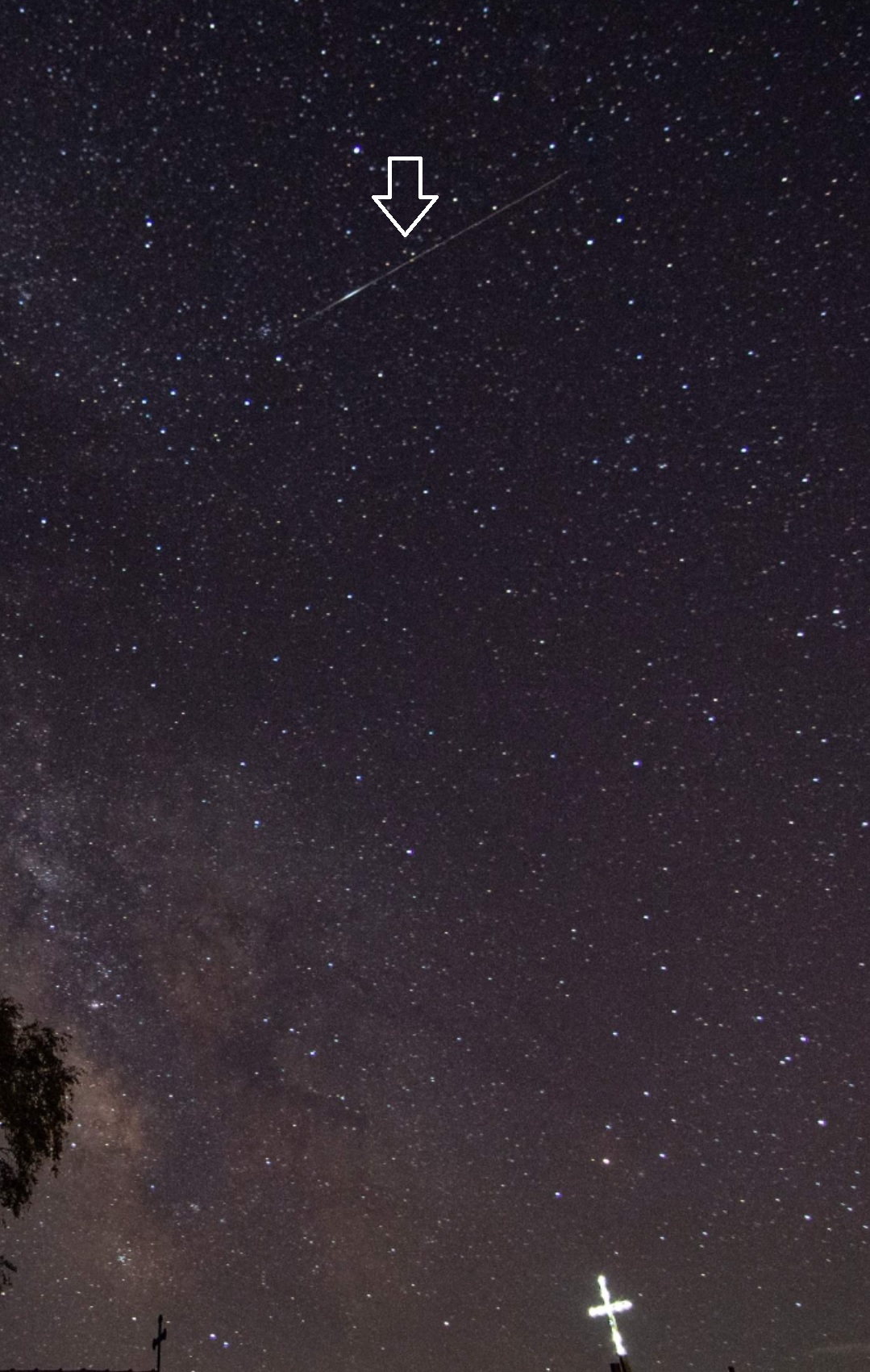
Figure 2 – Individual frame of one of the meteors from the unknown source.
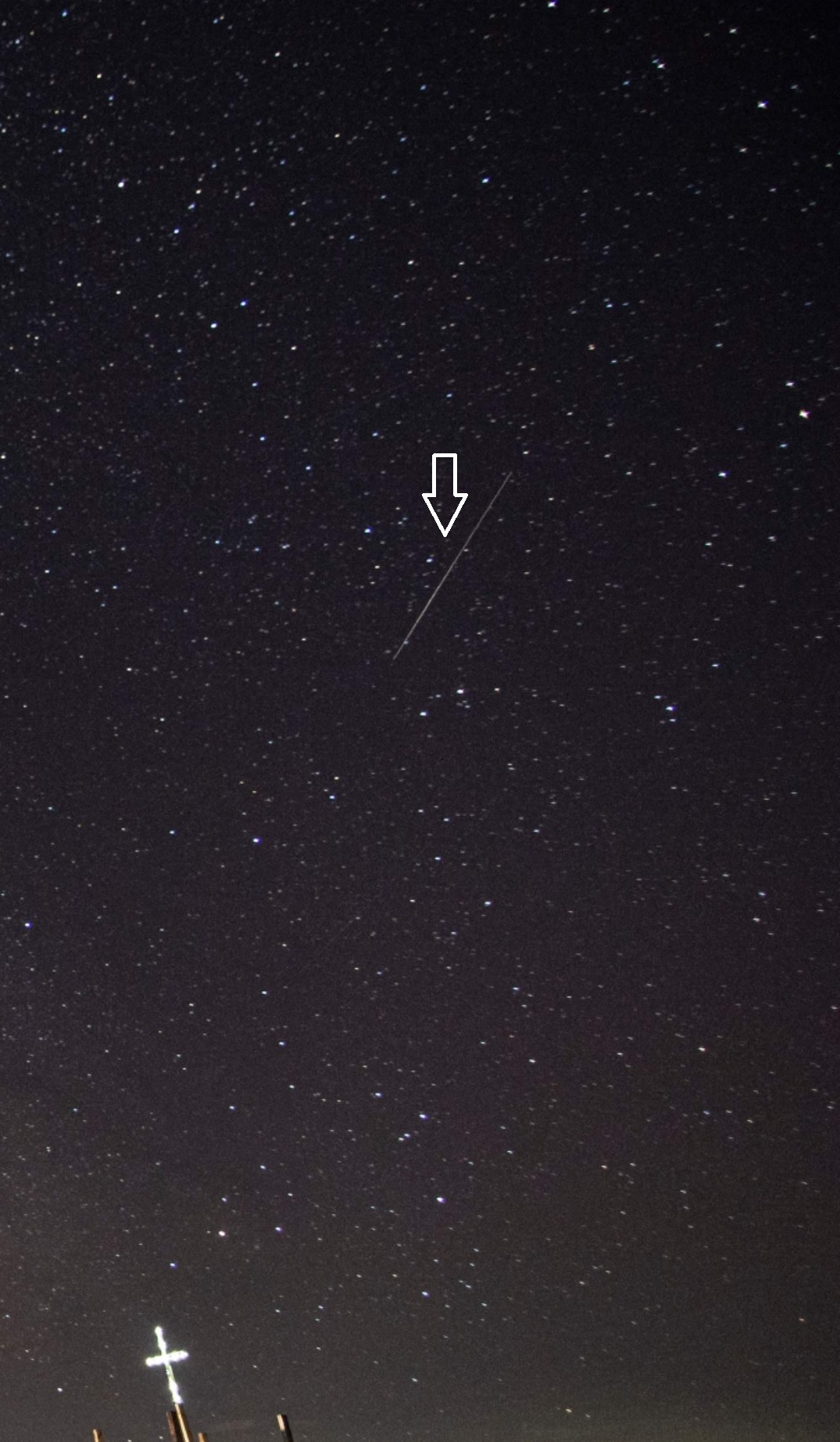
Figure 3 – Individual frame of one of the meteors from the unknown source.
2 The social media as a source of scientific information
The method is very common in astronomy, aka “data mining”. There are lots of visual, photographic, video networks which are storing exact information about meteors. Some of them are professional, other amateurs, but they all have correct information about meteor events, for which the most important is the date, time (in UT) and the location. To work with their data is easy and a pleasure. But why do I choose such a difficult and complicated source of information for my investigation? The answer is, because for some very rare events, so rare, that even the available numbers within networks are insufficient for their detection. For very short intervals of time and rare events, one thing is very important, which we call “luck”! During my work I saw some incredible examples. What would be the probability to catch one Perseid meteor from the main radiant, one late Piscis Australid meteor and one epsilon Perseid, which is actually not related to the Perseids, in one 30 seconds interval on a single frame? Three independent different events to be realized in such a short interval of time! Furthermore, it happened to a photographer, who for over five years has less than ten nights sky pictures! Or, another case happened to a photographer from Japan, who was waiting an entire night under a sky, covered with clouds. Accidentally early in the morning, when twilight appeared, the clouds started to resolve and the sky got clear. In this short time interval, he managed to catch one of the best examples of all the meteors from the new source!
That is why I decided to search among the pictures and videos in more widespread platforms such as Twitter, Facebook and Instagram, spread all over the globe. This way, the chance to find something increases, but at the expense of reliability! A wide spectrum of photographers: professionals, amateurs and art-photographers can be found here. They are using different quality equipment, but most of them don’t care about important details such as the time of the exposure. For them, the object or event they are photographing is the most important.
First, I want to share my own experience with working on those media. I already mentioned the time, or at least the date of the photography. Most of them are using descriptive categories such as: “during the Perseids this year”, “last Wednesday”, “a few days ago”, etc. Then I have to look for other, indirect circumstances such as the date of the post, the position of the planets Jupiter and Saturn in the nights around the maximum of Perseids, or the red glow of the sky around sunset and sunrise for the approximate time. In shots of missing planets, I even used the sequels of the Perseid directions captured in the frame and their distance from the ephemeris position of the radiant for the night of the maximum! Of course, if the source it had been active enough, I would have never wasted so much time to investigate all this, and I would just ignore every complicated case. But for an activity level which is many times less than the sporadic background, I can’t afford it. Sometimes the date of publication can serve as an approximate reference for the date, but this is not always mandatory. Photographs of Perseids can be found, weeks, months, and even years after they were taken. In such cases, the available references are the comments made by the authors of the photos, in which they explicitly mention when the photo was taken. Another problem is the reposting of the pictures after a long period of time since their previous publication. It is a very common practice among the photographers on Instagram. When I find a meteor, it probably belongs to the investigated radiant without any written date in the author’s comment, I had to follow all the author’s pictures from the very beginning of his account on the platform to be sure that it is the first appearance of that meteor picture!
For the art photographers it is very common to use one and the same sky background with meteors from many, different pictures, changing only the landscape below. The most strange and confusing case I have seen is a meteor, which matches very well with the possible new radiant, used by six different art photographers as a background for their art photos during four years! They have used it sometimes mirrored, sometimes upside down, sometimes as winter either summer time. It’s impossible to find who is actually the author, and when that meteor has been captured for the first time! (Acknowledgements number 74).
When I have to use some meteors from mosaic pictures, I’m very careful, because when some photographers are gathering meteors from different frames to one, they are doing it incorrectly. Instead trying to orientate the meteors according to their positions among the stars, they are doing it according to the landscape orientation. As a result, some real stars on the picture disappear and other new stars are appearing! And the last thing, among the hundreds of pictures, I have checked, there were pictures which matched the radiant very well but from another time of the year, which I ignore for this reason. This is not surprising as the possible new radiant is located close to the ecliptic, which is rich in ecliptic sources as well as sporadic meteors during the entire year.
As a conclusion, after all this I can say that using information from such social media requires to use something like a scale of reliability of the data comparable to the accuracy of the visual observations. The most reliable should be single frames with known date and time of the recording. The most unreliable are meteors from mosaic pictures or with unknown date but known period derived from the descriptions by the author.
3 Some results
My researches went in two directions, following a simple logic, if something really exists, it should reveal itself in space and time. At first, meteors of the same source would be photographed from different locations of the planet, as well as in the same period in the current year and also in this period in different years. I found evidence, I found meteors from the USA, UK, Bulgaria, Serbia, France, The Netherlands, Italy, Spain, Germany, Macedonia, Albania, Poland, Japan, Turkey, Ireland, Canarias Islands, Iran, and Denmark.
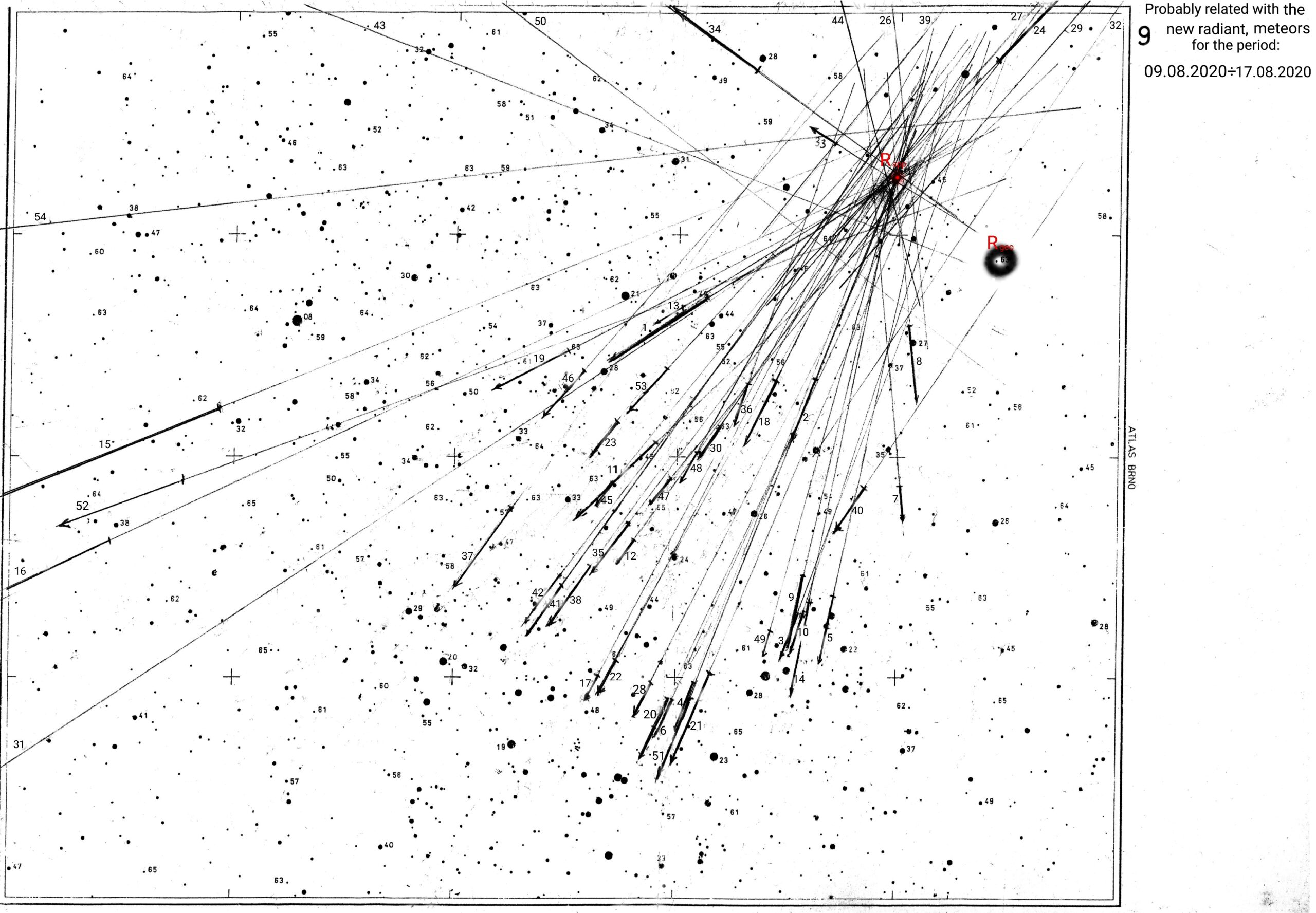
Figure 4 – The radiant, obtained by 59 meteors and the backwards produced trails on a gnomonic map for the period of 09 August –17 August 2020. The apparent radiant position is shown with Rapp, and the calculated geocentric radiant with Rgeo.
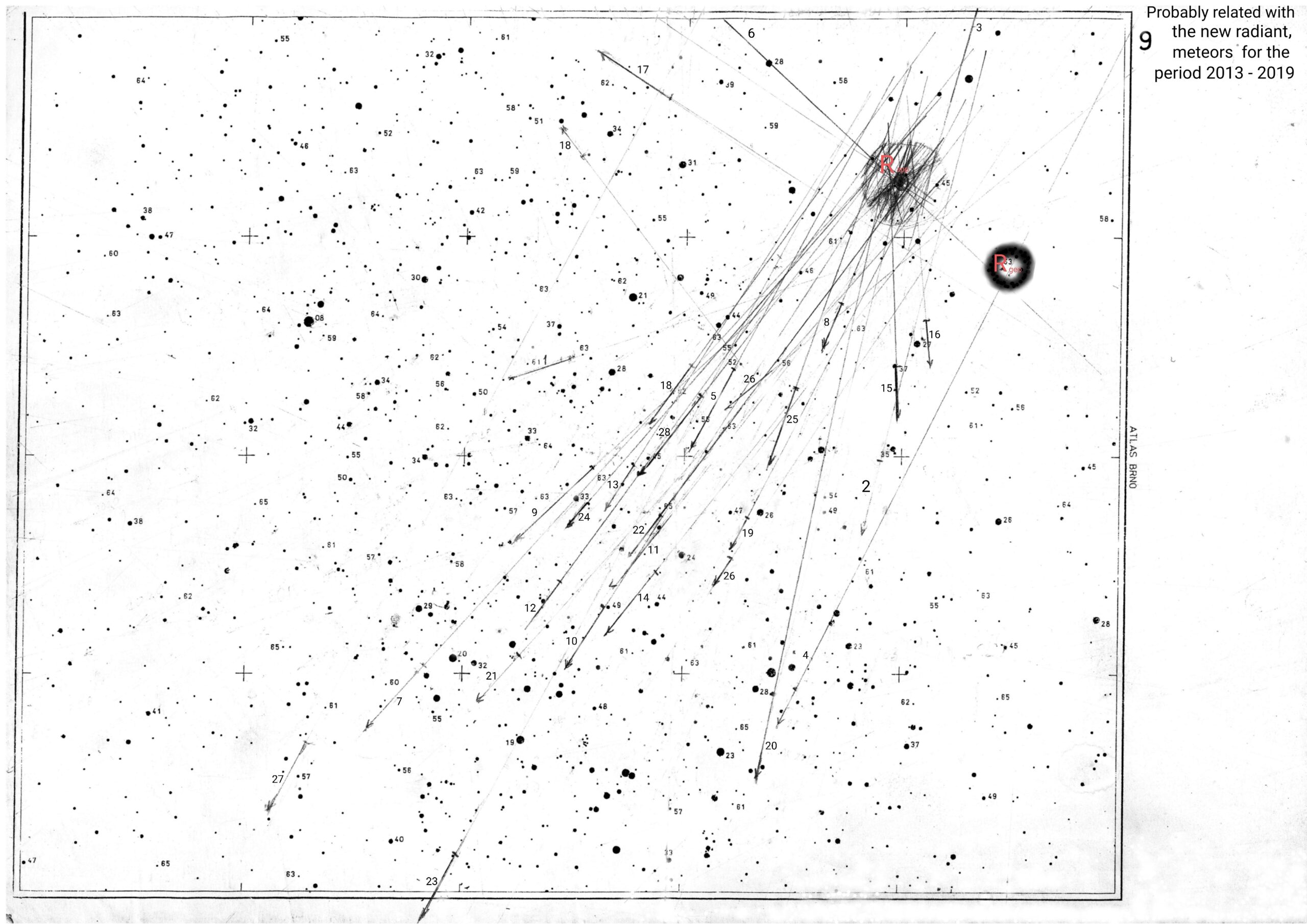
Figure 5 – 28 meteors and their backwards produced trails on a gnomonic map for the period of the Perseids in 2013, 2015, 2016, 2017, 2018, 2019 years, using the radiant positions from 2020. The apparent radiant position is shown with Rapp, and the calculated geocentric radiant with Rgeo.
After searching almost one year I found 59 meteors photographed in the year 2020 during the period between 9th and 16th of August, all coming from an area with a diameter of five degrees, which could belong to the new source. That area includes the daily motion of the radiant drift and the possible dispersion because of the different time and elevation of the radiant during the night. Figure 4 shows the position of the possible apparent radiant. The radiant is obtained graphically, by a precise transfer of all single meteors to gnomonic maps of Atlas Brno 2000, used by IMO for visual observations of meteors (Rendtel, 2014).
I found also meteors recorded in 2013, 2015, 2016, 2017, 2018 and 2019, shown in Figure 5.
The radiant position is located very close to the Antapex of the Earth’s orbit. That means, the meteoroids have to catch up with Earth and the meteors will be very slow. The position of the apparent radiant of such slow meteors is very sensitive to its zenithal distance because of the effect of the zenith attraction. The value of the difference with the position of the geocentric radiant depends on the apparent velocity. The higher the velocity, the less becomes this difference. The apparent velocity can be represented as a vector which depends on the directions of some of its components:
- the direction of the geocentric velocity vg, which is a geometric vector between the direction of the Earth on its orbit and direction of the meteoroid on its orbit as a difference between their heliocentric velocities.
- the direction of the gravitational attraction of the Earth, which gives to the body an additional acceleration, or pre-atmospheric velocity v∞.
- the vector of the direction of the diurnal aberration of the Earth because of its rotation, which depends on the latitude of the observer’s location.
- the direction of the Earth’s atmospheric resistance, which gives only a negative acceleration or deceleration. It is always oriented in the opposite direction to the direction of the apparent velocity.
Only when the apparent radiant is at the zenith its position coincides with that of the geocentric radiant, as the directions of the main components of the apparent velocity such as the geocentric and topocentric (pre-atmospheric) velocities also coincides. The influence of the diurnal aberration is negligible.
The effect is the strongest when the radiant is on the horizon, because then the two vectors make an angle of 90 degrees. Since the vector of the force of the Earth’s acceleration is the same for all meteor bodies, but the vector of the tangential velocity in the direction of motion of the meteoroid is different for different meteors, the effect is most pronounced in the slowest meteors.

Figure 6 – A drawing of the effect of the zenith attraction on the radiant. v∞ denotes the topocentric (pre-atmospheric) velocity, and u the apparent velocity of the meteor. The apparent velocity is changing during the movement of the meteor along its entire trajectory, so that its difference between its value at the beginning and ending of the trajectory includes the correction for the resistance of the atmosphere at its final stage. (Arlt et al., 2008).
The effect of the zenith attraction of the apparent radiant position could be calculated, using the following formula (Arlt et al., 2008):

Where z is the zenith distance of the apparent radiant and Δz is the correction of the radiant position in degrees.
The relation between vg and v∞ is given by the formula (Babadzhanov, 1987):

Where γ is the gravitational constant (γ = 6.673 ×10^–11 [m^3 × kg × sec^–2]), Mt the mass of the Earth (Mt = 5.976 × 10^24 [kg]), R the average radius of the Earth (R = 6.37 × 10^6 [m]). This means that at a sufficiently long distance, a body with zero relative velocity relative to the Earth would accelerate to 11.2 km/sec and it is the minimum possible pre-atmospheric velocity for a meteoroid.
Knowing the equatorial coordinates of the apparent radiant in Right Ascension and declination, the pre-atmospheric velocity v∞ and the geocentric velocity vg of the meteors of a given shower, a correction for the effect of the zenith attraction can be made by a transformation to the horizontal coordinate system.
The radiant corrected in this way is called topocentric. For the slowest meteors with a radiant located on the horizon, Δz can exceed 15 degrees!
Although less pronounced than the effect of the zenith attraction, the following effect must also be taken into account. The eastward displacement is calculated by the formula (Arlt et al., 1999):

where: β is the distance of the visible radiant from the point at East in azimuth at 0° elevation, φ the latitude of the location and Δβ is the correction of the position of the radiant.
After these two corrections, the position of the geocentric radiant is obtained, which, unlike the position of the apparent radiant, is the same for the whole Earth at a given moment in time.
This means that the area formed by the individual apparent radiants belonging to the possible new source, could be very large with a diameter of over 10 degrees around the position of the geocentric radiant! It can be assumed that if such a radiant exists, related meteors will be most likely captured at the highest position of the radiant above the horizon, which falls around the beginning of the local night for the middle North latitudes, where the density of observers is optimal. Their back-extended trajectories would come from an area with a higher concentration, shaping the position of the visible radiant at that time. All later meteors would give a wide blurred area around this position.
The most important is to have information about the velocity of the meteors which we don’t know.
I contacted Paul Roggemans and asked him to look up data from their video surveillance network in the BeNeLux. Of course, such meteors would be classified as sporadic meteors. He kindly provided me with this information, and there was only one meteor from 2013 with similar solar longitude and a radiant corresponding sufficiently with the search area. Its speed was expectable slow with a geocentric velocity of vg = 11.38 km/sec. Using that speed only as an approximate estimation I calculated the coordinates of the geocentric radiant to be at R.A. = 231º and Dec. = +12º. (Figure 7). I calculated this using a software, created in our Astronomical club Canopus many years ago.
Then, I looked for other sources of information from the NASA video archive of meteor observations for 2020, where I found a few radiants probably belonging to the new source (Figure 7).
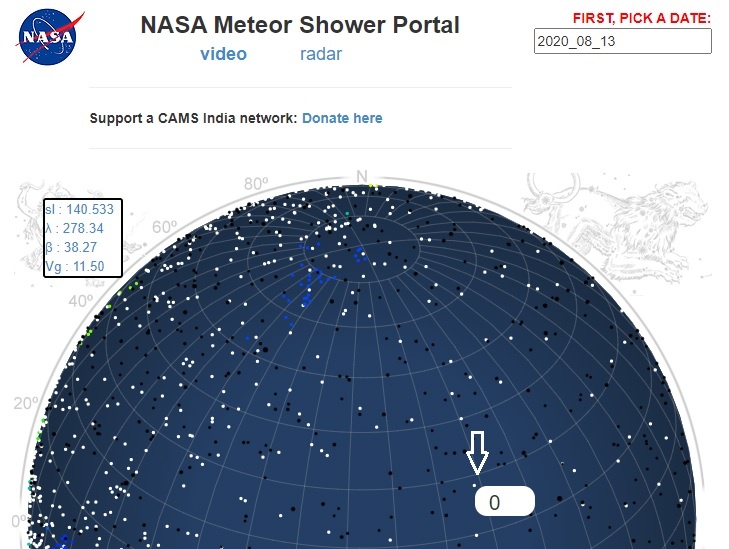
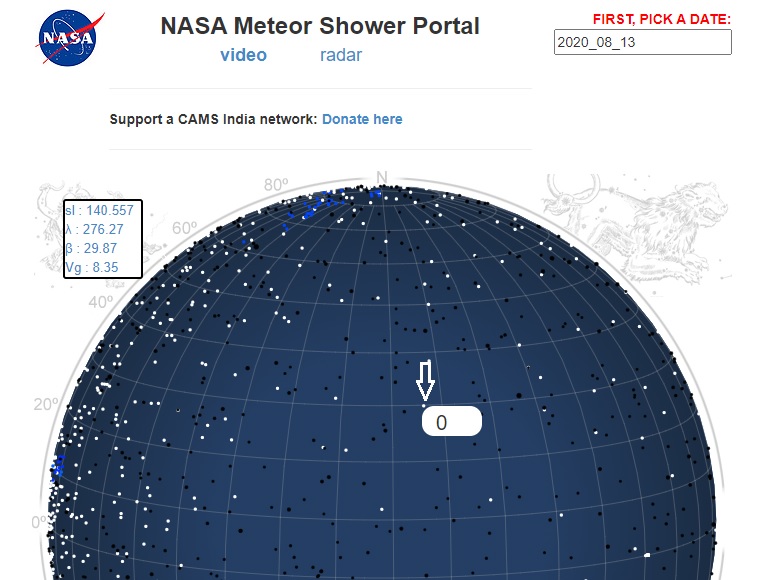
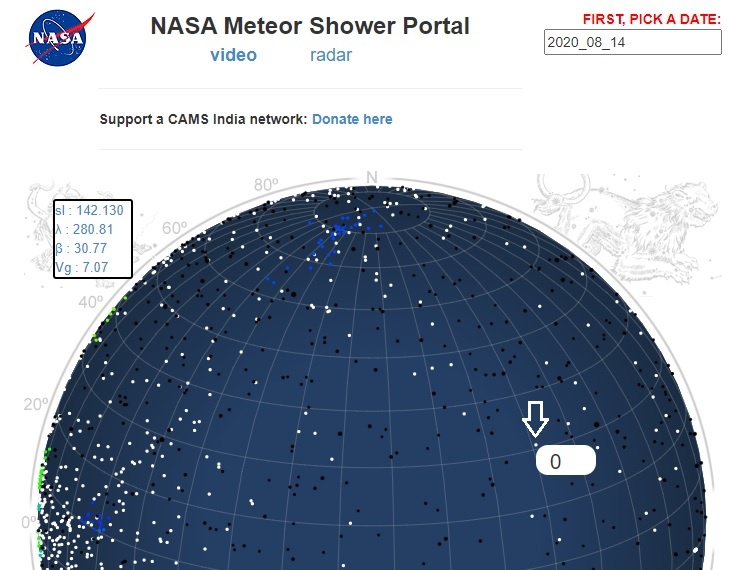
Figure 7 –Screenshots from the NASA archive for the nights 13th and 14th of August 2020. There are two close radiants from which, one is closer to the apparent radiant and the other closer to the geocentric radiant. The geocentric velocity of the first one is close to the velocity I have used for the calculation of the coordinates of the geocentric radiant. For the second radiant the geocentric velocity is even slower.
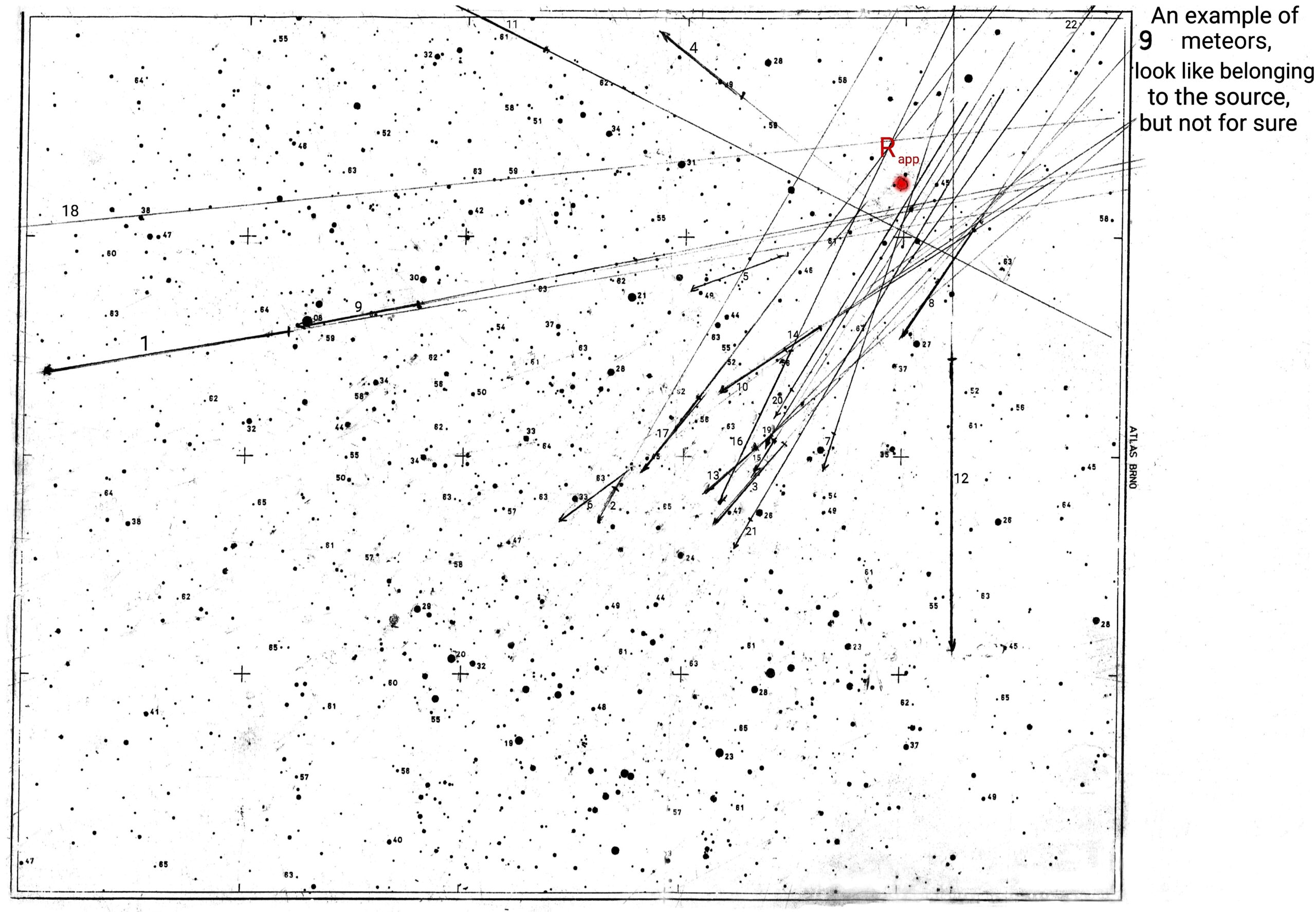
Figure 8 – An example with meteors which trails are matching very well with the radiant position of the new possible source, but with pictures, taken during another time of the year. There are only two exceptions. Meteor number one has no known date of the photography and author. It is used by six different art photographers as part of a background sky, for their art photocompositions. Especially one of them is using it many times, and it appeared for the first time in 2017. So there is a probability that he is the author and that the meteor has been recorded during the Perseid time in the same year. Another one, is the meteor number 12, which is a typical Perseid meteor from 2020, which trajectory accidentally lies on the direction to the new radiant.
I also downloaded the archive for previous years from 2011 to 2016 and among the huge amount of data I found only 14 very close but never identical individual radiants. For the recent years I also found individual radiants which could be associated with the suspect possible new shower.
What is the probability that a random meteor can be associated with an existing meteor shower radiant, only because of the direction of its trail? There are two different explanations: statistical and physical. In the first one it is just a coincidence, and for the second the physical relation of a common origin. In Figure 8 some examples of meteors are shown coming from the same area, but recorded at another time of the year as well as meteors from other radiants which are active during the same period, for instance Perseids, which are obviously not related to the suspected new meteor shower.
Is there among all those meteors any statistical relevant relationship? It could be! But their number will be hardly big enough to influence the results. A curious case is a Fireball captured this summer on June 9,2021, from Glashütte Sachsen, Germany, which is matching well with the position of the possible new radiant in August! It is logic that the background of the distant stars can be the same for many, different meteor radiants during the year.
As a joke, after more than 10 years of meteor observations in our Astronomical club Canopus, we reached to the conclusion, defined as a law: “Every point of the celestial hemisphere is a meteor radiant!” This fundamental meteor astronomy law, makes any searching for new radiants meaningless because every newly discovered source is simply a logical confirmation of this law!
4 Conclusions
This article cannot confirm unambiguously the existence of such a new shower radiant, as the requirement is, to have at least the orbital elements of three bodies, which needs video or radar observations with determined velocities of the meteors. The purpose of the article is just to pay attention to all so far sporadic meteors, coming from that area during the Perseids and if that new shower really exists, to be confirmed and included to the list of the meteor showers. I hope this year the question about the existence of the meteor shower rho Serpentids can be figured out.
Acknowledgments
I want to thank to Paul Roggemans for the information, given to me from the CAMS BeNeLux video network, for helping with advising me where to search more information from other sources and for editing my article. I want to thank also to Tim Cooper for ideas, which he gave me when we discussed that possible radiant.
And finally, I want to thank to all photographers, which meteors I used for my analyze. Some of them I will mention by their names, but others which names I don’t know, by their Instagram names as follow:
1.Kalina Stoimenova, Bulgaria, @kallystoimenowa; 2. P I K S, USA, @chriskpickens; 3.p_i_r_o_s_h_k_i , Serbia, @p_i_r_o_s_h_k_i; 4. Melanie Guerrero, Spain, @melg.photography, @melanieguerrero.photography; 5. Antonio Lobelle Toro, Spain, @lobellant; 6.Pablo.j, Spain, @pablo.jae; 7. Jose y Adrian, Spain, @locos_noctambulos; 8.Marcos del Mazo, Spain, @marcos_del_mazo; 9.Alberto Cañete, Spain, @albertoknt; 10.Tomasz Dyziek Szostak, Poland, @dyziekcom; 11. Cees Kassenberg Photography, The Netherlands, @case_Kassenberg; 12.@rongille, Japan; 13. Ehsan Yousefi, Iran, @ehsun.yousefi; 14. Ronny Behnert, Germany, @haggardphotography; 15. Arbër Shkurti, Albania, @fantastic_albania; 16. Takuya Yoshida, Japan, @takupocho; 17. Johnnie, Japan, @johnnie_photography; 18. Yoshinobu Naito, Japan, @shooting.brake; 19. @tsubassa_photo, Japan; 20. @monacamera, Japan; 21. Frank William, Canada, @sirfrankwilliam; 22. Caroline, Canada, @carrhayes; 23. Fernando D. Cala Dominguez, Canarias Islas, @fernandocala87; 24.Charalambos Chrysostomou, Cyprus @charalambos.chrysostomou; 25. Dom Reardon, UK, @dom_reardon_photo; 26. Etienne Simouneau, France, @tnnsmn; 27. Robert Urbaniak, Poland, @uerbe; 28. Haocheng Fang, China, @frankfang1; 29. Mario Shumanov, Bulgaria, @marioshumanov; 30. Riste Spiroski, North Macedonia, @ristespiroskiphotography; 31.@bigwednesday66, Canada; 32. Wobblycat’s Moto Adventures, Canada, @wobblycat; 33.Alfonso Cuchi, USA, @alfonsocuchi; 34. Dejan Kostic, Sweden, @dmkostic; 35. Nikolay Shopov, Bulgaria, @nikolayshopov.ph; 36.Wolfgang Falter, Austria, @falter.w; 37. Erin Malone,USA, @erinemalone; 38. Berk Uçak, Turkey, @omnesphoto; 39. Gareth Wray, Ireland, @garethwrayphotography; 40. Ole Spata, Germany, @olespata; 41.David Behan, Ireland, @davidbehan; 42.Holly Burton, UK, @_hollyburtonphotography; 43.Michal Mancewicz, Poland @kreyatif; 44. Paul O’Brien, Ireland,@mrpaulobrien; 45. Matt Melbert, USA, @mattmelbert; 46.Oz, Mexico, @elvaldo; 47. Kouji, Japan, mizumo1975; 48. Alberto Masó, Spain, @albertomaso; 49. Wesley White,USA, Alaska , @wesleywhitepro; 50. @aozoragaragemaa, Japan; 51. Ayumi, Japan, @ayumi.kosaka.121; 52. Pep Sanchez, Spain, @pepinair; 53. Ruslan Merzlyakov, Denmark,Norway, @astrorms; 54.Erik Colombo, Italy, @erikcolombophotography; 55. Joseph Zhao, USA, @josephsphotography; 56. Emma, UK, @emcon81; 57.Kenneth Denton,USA, @kennethhhd; 58. Max Pedi, Italy, @maxcrack90; 59. Cody Limber,USA, @codylimber; 60.Christopher M. Georgia, USA, @christophergeorgia.photography; 61.Carlos Fernandez, Spain; 62.Darla Young, USA; 63.Jeremy Perez, USA, @jperezmedia; 64. Arpan Das, Italy, @arpandas_photography; 65.ji-ji8800, Japan, @8800ktmt; 66. Alfonso Cuchi, USA, @alfonsocuchi; 67. Asif Islam, USA, @asif.photography; 68.Nick Page, USA, @nickpagephotography; 69.Amr Abdulwahab, Egypt, @amr_abdulwahab; 70.Amir H Dehqan, Iran, @amir.dqn99; 71. Mitch Stather, UK, @mitchellstather; 72. Kerry-Ann Lecky Hepburn, Spain, @weatherandsky; 73. Matteo Rovatti , Italy, @matteorovattiphotography; 74. ART: Brent Shavnore, USA,@shavrone; @daisuke_diving, Japan; @nights_dreamworld;@itsanoemithing, Spain; Sabrina, Switzerland,@sabrina.binkert; Plus Minus, @sven_plusminus; Volpe Imagens, @volpeimagens; 75. Sean Parker,USA, @seanparkerphotography; 76. Glashütte Sachsen, Germany.
References
Arlt R., Rendtel J., Brown P., Velkov V., Hocking W. K. and Jones J. (1999). “The 1998 outburst and history of the June Boötid meteor shower”. Monthly Notices of the Royal Astronomical Society, 308, 887–896.
Arlt R., Asher D.J., Brown P.G., Campbell-Brown M., Dubietis A., Koschack R., Koschny D., Lyytinen E., McBeath A., McNaught R.H., Molau S., Rentdel J., Roggemans P., Triglav M., Vaubaillon J., Verbeeck C., Wislez J.-M., Znojil V. (2008). Handbook for meteor observers, International Meteor Organization, Potsdam, Germany.
Babadzhanov P. B. (1987). “Meteors and their observation”. Science – Main edition of physical and mathematical literature, Moscow, U.S.S.R.


This search for new showers has always been, at once, fascinating and silly. It’s exhilarating to consider finding a true new shower, but so, so difficult to be sure. Data mining is hazardous to one’s mental health, so I’m not much of a fan. Too many spurious signals.
That’s why I have more or less ignored any showers that are not ‘obvious.’ When you’re watching the skies for a few hours, if there is a true shower in progress, it’s obvious – even if the hourly rate is only three. After all, three hours of three per hour gives you nine meteors radiating out from some small area of the sky. You can see it, feel it.
Unless this shower can dazzle me with its clear presence, I’m happy to ‘wait until next time’ to observe.
On the other hand, you never know…
Pete, from Central Florida